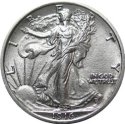During my coin roll hunting adventures over the past few months, I've not only been looking for older coins and coins made from precious metals, but I've also been looking for mint error varieties. I am a novice collector at best, so whenever I find something that looks neat, I post pictures of it on a coin collecting forum I belong to and several veteran collectors will look at the pictures and respond with what they believe the coin's error variety to be. Here are a few of my more notable finds and each one carries a premium over face value.
1964 D Nickel - Split Die
A Split Die is an extreme version of an error variety called a Die Crack. This error occurs when the die which strikes the coin begins to crack from the wear and tear of repeatedly striking coins. As with most cracks, they start out small, but eventually will expand until they stretch from coin rim to rim. When they have reached this later stage they become classified as Split Dies. These varieties are valuable because mint workers are supposed to continually inspect dies for Die Cracks (among other things) and remove / replace the die, therefore when a die reaches the stage where the crack has extended to the point of a Split Die, it's considered rare.
Estimated Value: $10.00
http://crhfinds.blogspot.com/2008/05/1974-d-nickel-die-crack.htmlThe reverse of this cent shows some smaller examples of Die Cracks. Note the thin raised lines extending from the coin's edge.
http://crhfinds.blogspot.com/2008/06/die-cracks-worth-keeping.html
1976 D Cent - Clipped Blank
Coins start out their life as a Blank, which is simply a circular wafer of metal, punched from a sheet of the metal used to make the coin.
Coin Blank:

A metal sheet is fed into a 'blanking' machine that punches row after row of these blanks. A Clipped Blank is the result of a mis-alignment in this blanking machine that causes a blank to be punched which overlaps a hole previously punched in the sheet. The result is a blank that has a curved chunk of metal missing from the edge. The blanking machines are normally very precise, so this type of error is considered rare and valuable.
http://crhfinds.blogspot.com/2008/06/1976d-lmc-planchet-clip.htmlEstimated Value: $3.00
1964 D Nickel - Lamination Error
A Lamination error is a coin with a metal missing or peeled off the coin's surface. These errors occur by way of things like dirt or gas trapped in the metal strips that make up the coins as they are rolled out to proper thickness prior to being punched into blanks. Because this type of error does not occur very often, it is considered rare and valuable.
Estimated Value: $4.00
http://crhfinds.blogspot.com/2008/06/lamination-error-or-post-mint.html
1983 Cent - Doubled Die Obverse (DDO) Error Variety
A coin's design starts off as two large hard-rubber molds with the coin's raised design on the surface. One mold for the front (obverse) design and one for the back (reverse) design. A computerized lathe then traces these molds and etches the design onto a much smaller cylinder of metal called a Die Blank, the result is called a Hub.
Die Blank:

Hub:

Hubs contain a raised version of the design, just like the coin. Since striking a blank with the Hub would result in a recessed design, we need to create a Die next. A Die is created by striking a similar metal cylinder with the Hub, resulting in a recessed design. The Die can then be used to strike a blank, resulting in the final raised designs we see on coins today.
Die:

There are two types of Hubs and Dies: Master and Working. The first hub created by way of the computerized lathing process is called the Master Hub. Normally only one Master Hub is created per design and has to last for as long as the design is used. To ensure this, the Master Hub is used only to make Master Dies. Master Dies, of which only a few are created, are then used to create Working Hubs. Many Working Hubs are created and then used in turn to create the final Working Dies which actually strike the coins. Thousands of Working Dies are created over the lifespan of a design. The process is similar to the way vinyl records are made and allows for a near infinite amount of exact duplicates to be made without worrying about long-term degradation of the original design.
Whew!
Now that we know the ins and outs of Hubs and Dies, we can get on with explaining what a Doubled Die error is.
When a Working Die is created, a Working Hub strikes a Die Blank to impart the design. Because of the metals hardness, multiple strikes are normally required in order to impart the design fully. If in between these strikes, the Working Hub somehow shifts in its alignment with the Working Die, the next strike will create design elements which are offset from the previously struck locations. The design elements therefore look 'doubled' and the creation of a Doubled Die has occurred. Since the doubled image has occurred on the die, every coin that is struck with that die will show the doubled image. These coins in turn are referred to as Doubled Die errors.
When Francine came to visit last week, she brought with her a pile of change which she had acquired so that I could look through it before she cashed it in. Unbeknown to her, Francine
was in possession of a 1983 Cent Doubled Die Obverse (DDO) error!
Estimated Value: $5.00
Note the doubling extremely evident in the letters G, O, D, and W of "GOD WE TRUST".
http://crhfinds.blogspot.com/2008/06/1983-ddo.html









